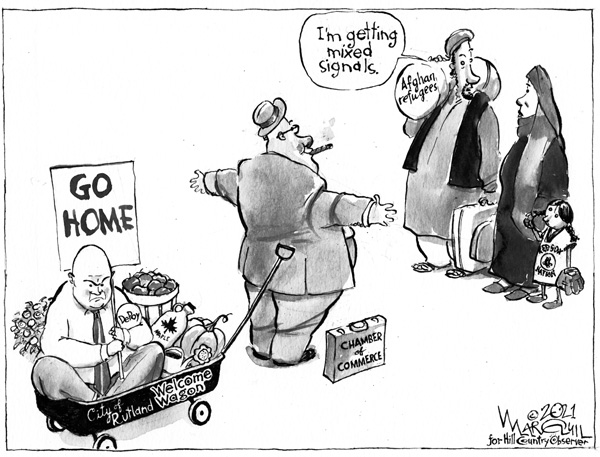Editorial October 2021
E D I T O R I A L
Refugees offer chance to counter city’s decline
The 2020 census figures released earlier this year offered yet another set of data to chart the long decline of Rutland.
The city, which throughout the 20th century was second only to Burlington in population among Vermont’s communities, now has fallen to fifth place, behind the Chittenden County towns of Essex, South Burlington and Colchester. It has lost more than 18 percent of its residents since 1970.
Rutland still has a lot of the infrastructure needed to sustain the more than 19,000 people who lived there 50 years ago. But today it’s supporting its roads, schools and water and sewer lines from a tax base that includes just 15,800 residents.
So it’s little wonder that Rutland’s business and community leaders are talking with renewed urgency about how to navigate the future as the local work force shrinks and ages – and how, perhaps, to slow or reverse those trends by attracting new people to the city.
And as our cover story this month details, the discussion has turned back gingerly to the prospect attracting foreign-born immigrants to the city, especially from among the tens of thousands of Afghan refugees now headed to the United States.
Gov. Phil Scott has already volunteered to have Vermont take in at least 100 people from the first wave of those fleeing the collapse of the U.S.-backed government in Afghanistan. And last month Rutland Mayor David Allaire said he’d support resettling some of the displaced Afghans in his city.
But hanging over these new commitments is the specter of Rutland’s divisive 2016 debate over immigration. In that case, then-mayor Christopher Louras worked out a deal to resettle 25 to 30 families of Syrian refugees in the city. The public dialogue turned nasty quickly, and it unfolded over the same months that Donald Trump was riding a wave of anti-immigrant sentiment to the White House.
To be sure, many Rutlanders embraced the 2016 resettlement effort as the right thing to do for humanitarian reasons. And Louras, surely aware of the long-term demographic trends, argued that an influx of new residents would give Rutland an economic boost.
Opponents, though, cast the scale of the resettlement project as something to be feared. And critics of the plan seemed to accept as an article of faith that the refugees would be an economic burden that would worsen Rutland’s economic stresses – despite the nearly unanimous agreement among economists that immigration has been a big net plus for other shrinking Rust Belt cities.
In the end, only a couple of families arrived in Rutland before the Trump administration shut off the flow of Syrian refugees into the United States. And Rutland voters resoundingly ejected Louras from the mayor’s office, replacing him with Allaire, a former alderman who campaigned with the support of resettlement opponents.
Now the city has a new opportunity to open its doors to refugees – and perhaps to find redemption for its image as a welcoming community. It might also be a chance to start reversing the economic decline of the past five decades.
Without question, an influx of immigrants won’t undo all of the factors that have contributed that decline. But people are the lifeblood of any city, and it’s a safe bet that Rutland’s economy will grow better and faster if it has more people working and contributing to it.


